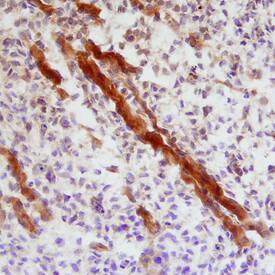Mouse Indian Hedgehog/Ihh N-Terminus Antibody
R&D Systems, part of Bio-Techne | Catalog # AF1705

Key Product Details
Species Reactivity
Validated:
Cited:
Applications
Validated:
Cited:
Label
Antibody Source
Product Specifications
Immunogen
Cys28-Gly202
Accession # P97812
Specificity
Clonality
Host
Isotype
Scientific Data Images for Mouse Indian Hedgehog/Ihh N-Terminus Antibody
Indian Hedgehog in Mouse Embryo.
Indian Hedgehog was detected in immersion fixed frozen sections of mouse embryo (15 d.p.c.) using Goat Anti-Mouse Indian Hedgehog N-Terminus Antigen Affinity-purified Polyclonal Antibody (Catalog # AF1705) at 15 µg/mL overnight at 4 °C. Tissue was stained using the Anti-Goat HRP-DAB Cell & Tissue Staining Kit (brown; Catalog # CTS008) and counterstained with hematoxylin (blue). Specific staining was localized to muscle cells. View our protocol for Chromogenic IHC Staining of Frozen Tissue Sections.Applications for Mouse Indian Hedgehog/Ihh N-Terminus Antibody
Immunohistochemistry
Sample: Immersion fixed frozen sections of mouse embryo (E13-15)
Western Blot
Sample: Recombinant Mouse Indian Hedgehog (C28II), N-Terminus
Formulation, Preparation, and Storage
Purification
Reconstitution
Formulation
Shipping
Stability & Storage
- 12 months from date of receipt, -20 to -70 °C as supplied.
- 1 month, 2 to 8 °C under sterile conditions after reconstitution.
- 6 months, -20 to -70 °C under sterile conditions after reconstitution.
Background: Indian Hedgehog/Ihh
The hedgehog (hh) gene encoding a secreted protein was originally identified in Drosophila as a segment polarity gene. The vertebrate homologues of Hh comprise several proteins including sonic hedgehog (Shh), Indian hedgehog (Ihh), and Desert hedgehog (Dhh) (1). Hedgehog proteins are important signaling molecules during embryonic development and are highly conserved within and across species (1). Mouse and human Ihh share 100% amino acid (aa) sequence identity in the signaling domain, while mouse Ihh and Shh share 90% aa identity in the N-terminal signaling domain. Ihh mRNA expression is detected in fetal lung, gut, stomach, liver, kidney, pancreas, and strongly in cartilage, in growth regions of the developing bone (2, 3). Ihh, along with parathyroid hormone related protein, regulate the rate of chondrocyte proliferation and differentiation (4). Ihh is also involved in yolk sac vasculogenesis, playing an important role in differentiation of epiblast cells into endothelial and red blood cells (5).
Mouse Ihh cDNA encodes a 411 aa polypeptide with a predicted 27 aa signal peptide. This polypeptide is cleaved to generate a 45 kDa precursor protein that undergoes the same post-translation processing as Shh (3). An autocatalytic reaction yields a 19 kDa amino-terminal domain Ihh-N protein that retains all known signaling capabilities, and a 23 kDa carboxy-terminal domain Ihh-C protein (3). Since hydrophobic modifications to Shh, including the substitution of the N-terminal cysteine residue with two hydrophobic isoleucine residues, can also increase its potency (6), a similar modification was made for Ihh. This modified form also shows increased potency in a bioassay measuring induction of alkaline phosphatase. At the cell surface, Hedgehog activity is mediated by a multicomponent receptor complex involving the 12-pass transmembrane protein Patched (Ptc) which binds Hedgehogs with high affinity and Smoothened (Smo), a signaling seven transmembrane G-protein coupled receptor (1).
References
- Ingham, P. and A. McMahon (2001) Genes & Dev. 15:3059.
- Marigo, V. et al. (1995) Genomics 28:44.
- Valentini, R.P. et al. (1997) J Biol Chem. 272:8466.
- Vortkamp, A. et al. (1996) Science 273:613.
- Byrd, N. et al. (2002) Development 129:361.
- Taylor, F.R. et al. (2001) Biochemistry 40:4359.
Alternate Names
Gene Symbol
UniProt
Additional Indian Hedgehog/Ihh Products
Product Documents for Mouse Indian Hedgehog/Ihh N-Terminus Antibody
Product Specific Notices for Mouse Indian Hedgehog/Ihh N-Terminus Antibody
For research use only
